Text
Science and History Week - Thursday, September 29, 2022
Want to learn more about the research, science, and history of Waterton-Glacier International Peace Park? Tune in to our four presentations this week!
Thursday, September 29, 2022
Title: Digitally Preserving Culturally Modified Trees at Kootenai Brown's Homestead
Time: 12 noon to 12:50 p.m.
Presenters: Dr. Peter Dawson, Head. Department of Anthropology and Archaeology, University of Calgary; Edwin Knox, retired Parks Canada Cultural Resource Management Program Lead - Waterton Lakes
Presentation Description: In the study and recording of the Kootenai Brown 1906-1913 homestead/cabin location, the site was found to include numerous "culturally modified aspen trees", including a Joe Cosley tree ...initials "JC", trademark "heart" and "29" (1929). The recording of "Poplar Grove" was made by Doctor Peter Dawson and his team from the University of Calgary Department of Anthropology and Archaeology using 3-D laser photography, as part of a program of digital preservation of Alberta heritage at risk. The effort includes collaboration with Parks Canada, Nature Conservancy Canada, Waterton Biosphere Reserve Association and the Alberta Heritage Conservation group. The original homestead cabin still stands - a feature of the pioneer museum in Pincher Creek.
Registration Link:
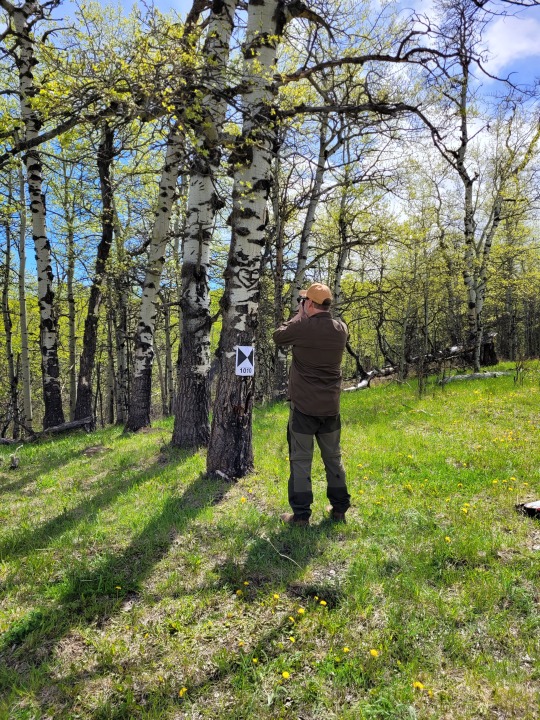

Learn more about Science and History Week and the presentations: Science & History Week - Crown of the Continent Research Learning Center (U.S. National Park Service) (nps.gov)
25 notes
·
View notes
Text
Science and History Week - Wednesday, September 28, 2022
Want to learn more about the research, science, and history of Waterton-Glacier International Peace Park? Tune in to our four presentations this week!
Wednesday, September 28, 2022
Title: Grizzly Bear Use of Army Cutworm Moth Aggregations in Glacier National Park
Time: 12 noon to 12:50 p.m.
Presenter: Erik Peterson, M.S. Graduate, Washington State University
Presentation Description: Army cutworm moths (Euxoa auxilliaris, ACM), are migratory insects, splitting their annual lifecycle between low elevation plains/basin habitats and high elevation mountain talus slopes. They have a propensity to aggregate in great numbers (like an army) wherever they occur during their annual life cycle. Due to the moths’ colossal aggregating habit, talus slopes where ACMs occur present a food buffet for grizzly bears, much like a huckleberry patch, where they can feed on up to 40,000 moths per day (an equivalent of a 20,000 calorie/day diet). For his thesis, Erik evaluated foraging sites across high elevation talus slopes throughout Glacier and assessed key environmental drivers of grizzly bear foraging to refine predictive habitat modeling and quantify the seasonal importance of ACM’s to grizzly bear diets in the region.
Registration Link:
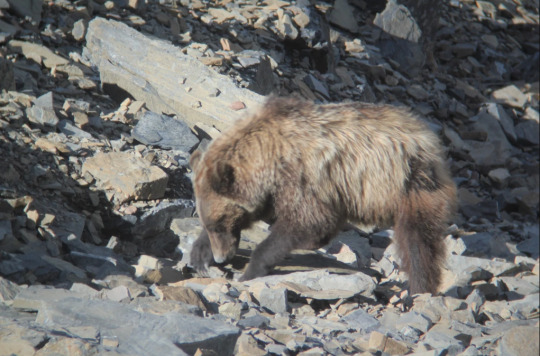

Learn more about Science and History Week and the presentations: Science & History Week - Crown of the Continent Research Learning Center (U.S. National Park Service) (nps.gov)
10 notes
·
View notes
Text
Science and History Week - Tuesday, September 27, 2022
Want to learn more about the research, science, and history of Waterton-Glacier International Peace Park? Tune in to our four presentations this week!
Tuesday, September 27, 2022
Title: The Half-moon Hairstreak Butterfly Recovery Project in Waterton Lakes National Park
Time: 12 noon to 12:50 p.m.
Presenters: Dr. James Glasier, Conservation Population Ecologist, Calgary Zoo
Presentation Description: The Half-moon Hairstreak (Satyrium semiluna) is an endangered butterfly with a limited range in Canada. It is found at eight localities in British Columbia and one locality in Alberta. The Alberta locality where Half-moons are found is in Waterton Lakes National Park on the Blakiston Fan, an area of about 3 km2. In collaboration with Parks Canada and the Sperling Lab at the University of Alberta, the Wilder Institute/ Calgary Zoo is working to conserve this endangered butterfly through monitoring its population, removing invasive plants from the fan, assessing habitat, understanding Half-moon natural history, and through conducting genetics work to understand population genetics. This work aims to conserve and protect the Albertan Half-moon Hairstreak population while potentially informing on additional steps that could be taken, such as translocations to reinforce or protect the current population in Waterton Lakes National Park.
Registration Link:
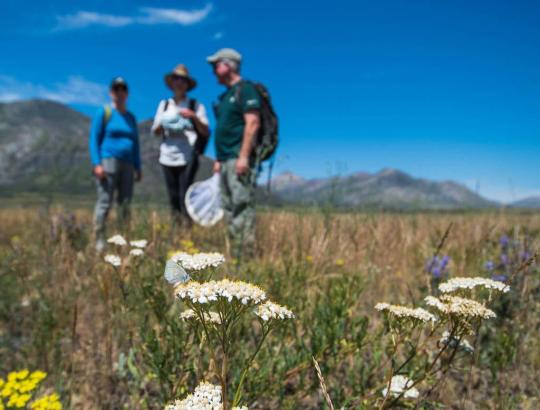
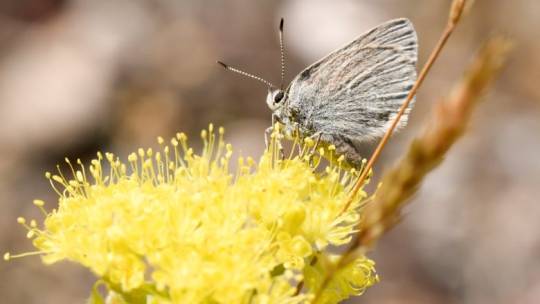
Learn more about Science and History Week and the presentations: Science & History Week - Crown of the Continent Research Learning Center (U.S. National Park Service) (nps.gov)
12 notes
·
View notes
Text
Science and History Week - Monday, September 26, 2022
Want to learn more about the research, science, and history of Waterton-Glacier International Peace Park? Tune in to our four presentations this week!
Monday, September 26, 2022
Title: The Montana Memory Project: Your Online History Research Resource
Time: 12 noon to 12:50 p.m.
Presenter: Jennifer Birnel, Montana Memory Project Director, Montana State Library
Presentation Description: This presentation will involve showing off the Glacier National Park photos and Superintendent's reports on the Montana Memory Project website. A live demonstration will be provided to orient participants to the website and key search functions for historical images or documentation.
Registration Link:
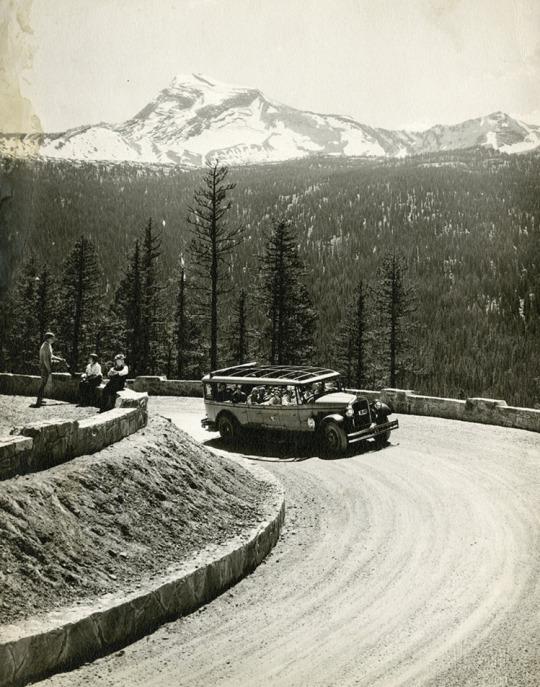

Learn more about Science and History Week and the presentations: Science & History Week - Crown of the Continent Research Learning Center (U.S. National Park Service) (nps.gov)
15 notes
·
View notes
Text
Appetite for Education
This grassland makes the perfect lunch foraging place for the appetite of a hungry black bear! During your lunchbreak, do you have an appetite for learning something new? Then we have the event for you!
Learn about current research and historical topics related to Waterton-Glacier International Peace Park by tuning into Science and History Week 2022! Beginning Monday, September 26 through Thursday, September 29, 2022, we will host a special presentation each day from noon to 12:50 p.m. Find more information about the presentations and register here: https://www.nps.gov/rlc/crown/science_history_week.htm
Monday, September 26, 2022 - The Montana Memory Project: Your Online History Research Resource
Tuesday, September 27, 2022 - The Half-moon Hairstreak Butterfly Recovery Project in Waterton Lakes National Park
Wednesday, September 28, 2022 - Grizzly Bear Use of Army Cutworm Moth Aggregations in Glacier National Park
Thursday, September 29, 2022 - Digitally Preserving Culturally Modified Trees at Kootenai Brown's Homestead
This photo was taken with a telephoto lens. Remember to keep a distance of at least 100 yards from bears and wolves and 25 yards from any other wildlife.

12 notes
·
View notes
Text
Science and History Week
Science and History Week is back for another year of exciting presentations! Beginning Monday, September 26 through Thursday, September 29, 2022 a special presentation will be hosted each day from noon to 12:50 p.m. The series will highlight current research and historical topics related to Waterton-Glacier International Peace Park. Each presentation will give viewers the opportunity to connect with scientists and historians from the Peace Park and get a unique look at archives, insights, and latest findings from Glacier and Waterton Lakes National Parks. Each presentation will have its own registration link. Check out this link to learn more about each presentation and to sign up: Science & History Week - Crown of the Continent Research Learning Center (U.S. National Park Service) (nps.gov)
Monday, September 26, 2022 - The Montana Memory Project: Your Online History Research Resource
Tuesday, September 27, 2022 - The Half-moon Hairstreak Butterfly Recovery Project in Waterton Lakes National Park
Wednesday, September 28, 2022 - Grizzly Bear Use of Army Cutworm Moth Aggregations in Glacier National Park
Thursday, September 29, 2022 - Digitally Preserving Culturally Modified Trees at Kootenai Brown's Homestead

6 notes
·
View notes
Text
The Artwork of Fossils and Geology in Glacier National Park
The formations found in the fossils and geology at Glacier National Park are a work of art!
The wavy appearance of stromatolite fossils in Glacier National Park may remind you of the sky in Vincent van Gogh’s The Starry Night. These mesmerizing swirls represent one of the earliest life forms on our planet. If we traveled back in time in Glacier National Park to over 1 billion years ago, we would find ourselves transported to a landscape that was covered by a vast, shallow sea. In the warm water cyanobacteria, or blue-green algae, carried out photosynthesis and helped to create an oxygen rich environment. Cyanobacteria, mixed with sediments is what causes stromatolites to form. Sediments become trapped and the algae grows through the sediments. This creates the distinctive layers of algal mats and sediment. Overtime, the layers flatten out and keep expanding. Stromatolites form in different shapes including conical, stratiform, branching, domal, and columnar. Some of the oldest stromatolite fossils found in Glacier National Park are in the upper Altyn Limestone (1.35 to 1.45 billion years old) near Apikuni Falls. They can also be found in the Appekunny and Grinnell Formations, the Siyeh Formation, the Snowslip Formation, and the Shepard and Mt. Shields Formations. They were widespread and abundant during the Precambrian (4,500 to 500 million years ago) forming reef-like structures known as bioherms. Today similar living stromatolites can be found in tidal channels in the Bahamas and Australia. The stromatolites in Glacier National Park are some of the oldest fossils preserved in any National Park Service unit and the variety of stromatolite fossils here is one of the richest accumulations of Precambrian life in the United States.
What artistic interpretations can you find in the fossils and geologic formations of Glacier National Park?
Read more about stromatolites: https://www.nps.gov/articles/park-paleo-fall-2018-stromatolites.htm
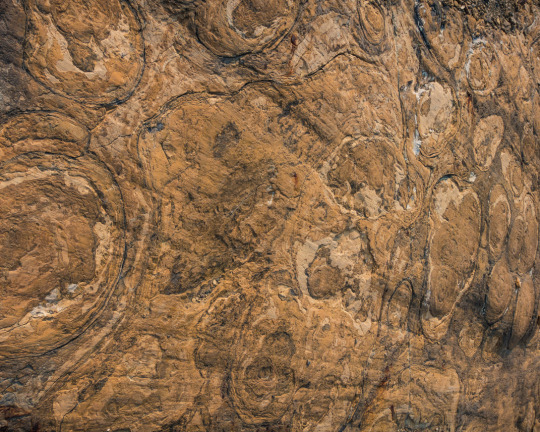



14 notes
·
View notes
Text
Happy Women’s Equality Day!
Today marks the 102nd anniversary of the adoption of the Nineteenth Amendment which gave women the right to vote. The women that fought for this right secured the ability for future generations of women to make their voice heard.
Glacier National Park has been influenced by many amazing women who help to protect this park. Earlier this summer, Glacier National Park hosted a STEAM Camp for Girls and held a Women in Science Career Fair where the middle-school girls could speak to women who work for the National Park Service, the United States Geological Survey, Montana Fish, Wildlife, and Parks, and the Flathead Electric Cooperative. The young women who participated in the camp are interested in pursuing careers in science, technology, engineering, arts, mathematics, and more. During the career fair, the girls were able to learn more about the career fields they were already interested in and learn about jobs they may not have known about previously in an environment where they can safely ask questions and develop hands-on skills. Investing in the futures of these young women places them on a journey to become influential leaders. We can’t wait to see what they do, and we are thankful for the incredible women who are leading the way!
Thank you to the Glacier National Park Conservancy for providing funding for the STEAM Camp for Girls!
Learn about women’s history: Women's History (U.S. National Park Service) (nps.gov)
Learn about careers in the National Park Service: Careers in the National Park Service (U.S. National Park Service) (nps.gov)


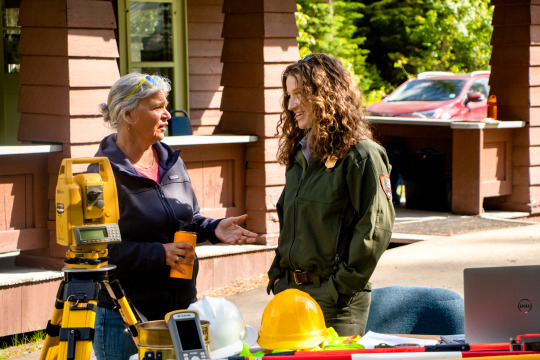

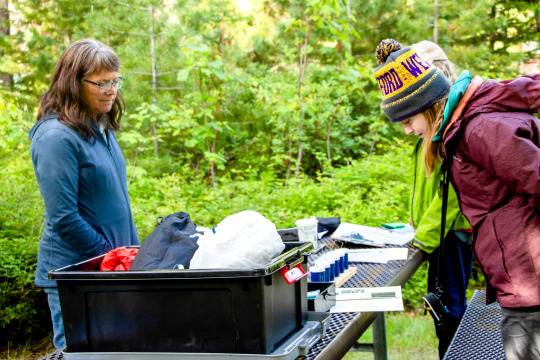


7 notes
·
View notes
Text
Colorful Night Skies in Glacier National Park
Fire, the Aurora Borealis, and shooting stars from the Perseid meteor shower have been lighting up the night sky in Glacier National Park, creating some beautiful color palettes.
As an International Dark Sky Park, Glacier is a great place to appreciate the beauty of the night sky. While the peak night of the Perseid meteor shower has passed, they remain active until the beginning of September. A few other meteor showers that are peaking the rest of this year include:
Draconids – Oct 8-9, 2022, up to 10 meteors per hour
Orionids - Oct 20-21, 2022, up to 10-20 meteors per hour
Southern Taurids - Nov 4-5, 2022, rarely produces more than five meteors per hour
Northern Taurids - Nov 11-12, 2022, similar to Southern Taurids
Leonids - Nov 17-18, 2022, around 15 meteors per hour
Geminids - Dec 13-14, 2022, over 50 meteors per hour or over 100 per hour in peak years
Ursids - Dec 21-22, 2022, around 5-10 meteors per hour
Glacier's Dusty Star Observatory Sky Cam: https://www.nps.gov/media/webcam/view.htm?id=FEBE3539-D0B5-B95A-B341B5A5C777FB9E
Check out the forecast for the Northern Lights: Aurora - 30 Minute Forecast | NOAA / NWS Space Weather Prediction Center
To find out more about fire in Montana check out: www.mtfireinfo.org
For more information on the Quartz Fire pictured in the first and third photos go to: Quartz Fire Information - InciWeb the Incident Information System (nwcg.gov)
What is your favorite night sky event you have experienced?
Photos: NPS/Kristin Vinduska




23 notes
·
View notes
Text
What would Glacier National Park be without water?
Water provides a necessary resource to sustain life on the landscape and creates iconic scenery comprised of waterfalls, streams, and lakes throughout the park. The water in Glacier includes 762 lakes amounting to 25,622 acres and 563 streams traversing a total of 2,865 miles.
Water is just as essential to our well-being. The forecast for this time of year is predicting many days above 90 degrees Fahrenheit or above 32 degrees Celsius. It is important to plan ahead by bringing plenty of water while outdoors. To beat the heat, make sure to drink water, eat salty snacks, avoid strenuous activities in the heat of the day, and wear sun protection including hats, sunglasses, and sunscreen.
Glacier National Park has water bottle filling stations located throughout the park to be utilized to replenish your water. Using these filling stations and reusing water bottles also helps to reduce waste. A map listing the locations of the filling stations can be found here:
Water wonderful place to explore! Remember to stay hydrated!
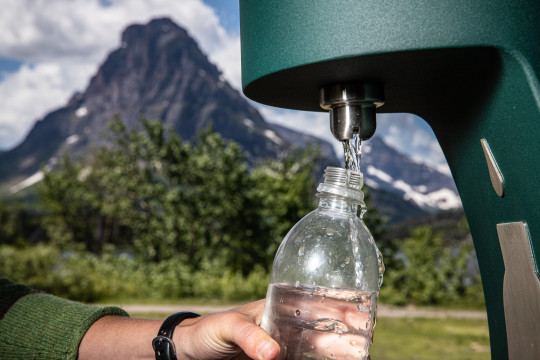
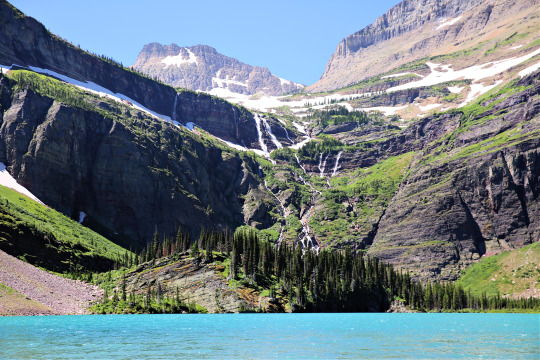
17 notes
·
View notes
Text
That Friday Feeling...
Glacier’s mountain goats are starting to shed their winter coats and relax in the summer sun!
They primarily live in alpine and subalpine environments making daring traverses of cliffs. These skilled climbers use their large, muscular forequarters to climb steep slopes of 60 degrees or more. Mountain goats have hooves that split into two toes, or cloven hooves, that can spread out when needed. This, along with soft, flexible inner pads, allows the goats to grip on to rocky ledges and cliffs, with the occasional stop to get some shut-eye.
Help to protect wildlife and yourself in Glacier by giving them space. Visitors are required to keep a distance of at least 100 yards from bears and wolves and 25 yards from any other wildlife including mountain goats.
This photo was taken with a telephoto lens.

17 notes
·
View notes
Text
Beargrass (Xerophyllum tenax) is blooming in the park!
What do you think of when you see beargrass? … A beautiful sign of warmer weather? … a tasty treat? … cozy material for a den? … a flower that looks like it belongs in a Dr. Seuss book? … cotton swabs?
This Montana native can grow up to five feet in height with a cluster of small white flowers at the top of the plant and grassy-like basal leaves at the base of the thick stalk. There is a myth that mass blooms occur every seven years but park managers have noted this abundance of blooms is much more variable and can occur every three to ten years. You will find different individual beargrass plants blooming every year when climatic conditions are favorable. Blooming typically starts in late May in lower elevations and can continue through August in the high country with a variety of appearances.
Although this plant is called beargrass, you typically won’t find any bears chowing down on it, but they have been known to collect the leaves as denning material. Beargrass is a food source for sheep, deer, elk, and goats. Humans also utilize this amazing plant. Indigenous people have long used beargrass leaves for basket weaving, roasted rhizomes for food, and leaf fibers for clothing. It can also be used for cosmetic and medicinal purposes. Other common names for this plant include basket grass, elk grass, pine lily, bear lily, and turkeybeard.
(The first photo is from 2012. The other three photos are from this year.)

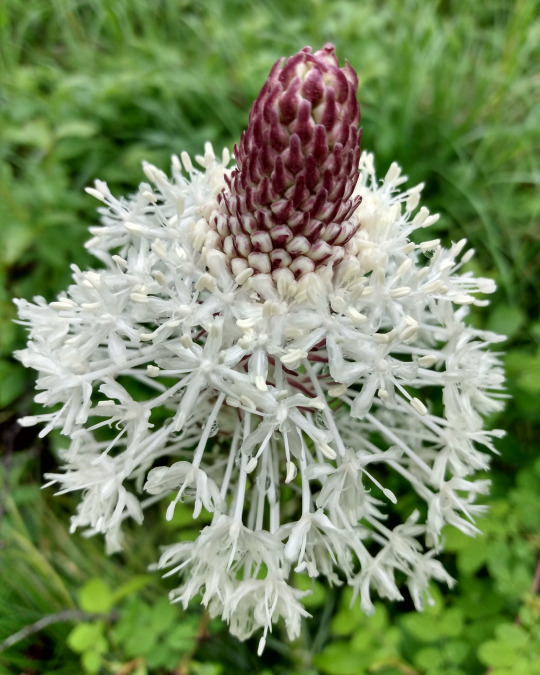


39 notes
·
View notes
Text
Glacier is going solar!
This week, Glacier National Park hosted a ribbon-cutting for the solar panels on the park’s headquarters building to celebrate renewable energy! The 108 photovoltaic solar panels were installed last year and have already been helping to reduce energy costs and greenhouse gas emissions. Since going live, the panels have generated over 25,000 kWh of electricity in the past year. This equates to 39,013 pounds per year of carbon dioxide offset which is equivalent to planting 293 trees every year or driving the Going-to-the-Sun Road 880 times. The park also uses solar power at the Logan Pass Visitor Center, the Apgar Visitor Center, the Goat Haunt Pavilion, the Polebridge Ranger Station and at some of the park’s fire lookouts. Thank you to the Glacier National Park Conservancy and Everybody Solar for making this project possible!
Learn more about sustainability at Glacier National Park: https://www.nps.gov/glac/getinvolved/sustainability.htm


20 notes
·
View notes
Text
Happy Pollinator Week!
What is a pollinator? A pollinator is anything that helps carry pollen from the stamen (male part of the flower) to the stigma (female part of the same or another flower). This movement of pollen causes the plant to become fertilized so it can produce seeds, young plants, and fruits. While some plants are self-pollinating or fertilized by pollen being carried by wind or water, other plants are pollinated by insects and wildlife. This can include bees, butterflies, moths, wasps, flies, birds, and small mammals, including bats.
What is all the buzz about? Pollinators help to provide resources essential to quality of life on earth including food, clean air, habitat, stable soils, and biodiversity. The hard work of pollinators yields all kinds of fruits, vegetables, and seeds. Insects and animals pollinate at least 75 percent of all the flowering plants on earth! This amounts to more than 180,000 different types of plants and 1,200 food crops. Pollinators’ major role in crop production means they contribute to a healthy economy. People and pollinators are deeply connected!
Pollinators are threatened by climate change, habitat loss, non-native species, parasites, diseases, and pesticides. You can help take action to help protect pollinators in your own backyard by providing them with healthy habitat as they help to sustain ours! Check out these resources to learn more: Helping in Your Backyard - Pollinators (U.S. National Park Service) (nps.gov) and Pollinators (U.S. National Park Service) (nps.gov)
What do pollinators provide for you?
#PollinatorWeek #RecreateResponsibly



19 notes
·
View notes
Text
Help to combat invasive species in Glacier National Park!
Glacier’s Citizen Science Program is looking for volunteers to help with their Noxious Weed Blitz on July 19 from 10:00 a.m. to 3:00 p.m. in West Glacier. This free event is open to the public. All “weed warriors” should bring gloves, appropriate footwear, and drinking water. Attendees will learn about identifying five invasive species, how they threaten native plants and wildlife, and how to remove them. Volunteers will be provided a complimentary lunch from the Glacier National Park Conservancy. Parking and meeting location details will be provided after registering. Space is limited. Participants must sign up by July 13 by emailing [email protected] or calling (406) 888-7986. Learn more about this event: https://www.nps.gov/glac/learn/news/-weed-warriors-needed-to-target-invasive-species.htm

14 notes
·
View notes
Text
"Take only pictures, leave only footprints"
That is a mighty big footprint to leave!
While it is thrilling to see signs of wildlife leaving their “footprints” as they traverse throughout the park, when visiting Glacier, we encourage you to reduce YOUR footprint! One easy way to do this is to “be idle free – turn the key!” When stopping your vehicle in a safe place, like parking lots, at scenic viewpoints and trailheads, or while stopped in traffic and road construction, reduce your idling impact by turning your vehicle off or by limiting your idling to no longer than two minutes. This aids in better air quality for the park and benefits the health of all living beings that inhabit and visit Glacier. It also saves fuel and helps preserve natural soundscapes by decreasing vehicle noise. This action may seem small, and one person might not make much of an impact, but if the over 3 million visitors that come to Glacier National Park every year each did their part, a cumulative difference would be made! You can also minimize your impact by reducing food waste, replacing single-use products with things like reusable water-bottles, using the park’s recycling system by recycling aluminum cans, #1 plastic bottles, and paper, and packing out your trash when it cannot be thrown away.
Make a modification to the phrase, “Take only pictures, leave only footprints” by taking actions to reduce your footprint when visiting Glacier!
Find out more about sustainability in Glacier National Park: Sustainability - Glacier National Park (U.S. National Park Service) (nps.gov)
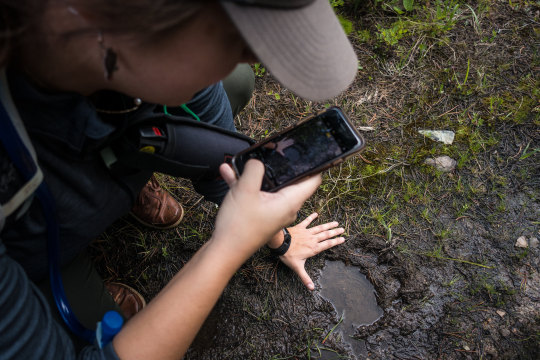
33 notes
·
View notes
Text
Rare Orchid Found in Glacier
Spring brings new life to the landscape. New discoveries develop along with the green hues of plant life returning to the landscape. There are over one-thousand species of vascular plants that have been documented in Glacier National Park, but this does not mean there are not more to discover!
A few years ago, a previously undocumented orchid was discovered in the park. Cypripedium fasciculatum, or clustered lady’s slipper, is native to western North America and is often found growing in moist stream terraces, commonly in partially to fully-shaded coniferous forests or cool, seasonally dry mountain slopes. Clustered lady’s slipper occurs in small, isolated populations and is fairly uncommon.
You can identify this plant by its namesake “slipper,” or the inflated lip part of the flower, in the spring and early summer. The variety of color can span from completely purple-brown to purple-brown marks on a green or golden background. One to nine droopy flowers may develop on the flowering stem.
Clustered lady’s slipper is pollinated by female wasps in a family known as the Diapriid Family, a group of parasitic wasps. The insects are in search of fungus gnats. These wasps use fungus gnat larvae or pupae as hosts. It has been theorized that the scent of this orchid mimics larval fungus gnats. It turns out we are not the only ones that enjoy stopping to smell the flowers!
Cypripedium fasciculatum is listed as a species of concern with the Montana Natural Heritage Program. Help protect fragile plant life while visiting the park. Leave areas untrampled and leave things where you find them. If you are curious about what species you see in the park, taking a photo is great way to help get an identification. If you stay curious, who knows what you might discover!

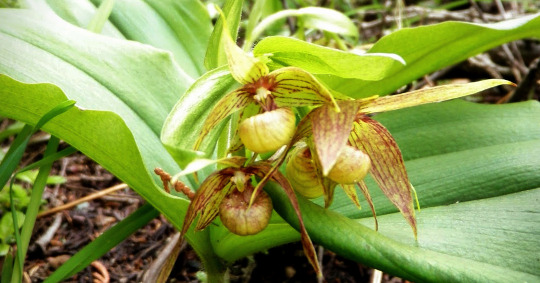
24 notes
·
View notes